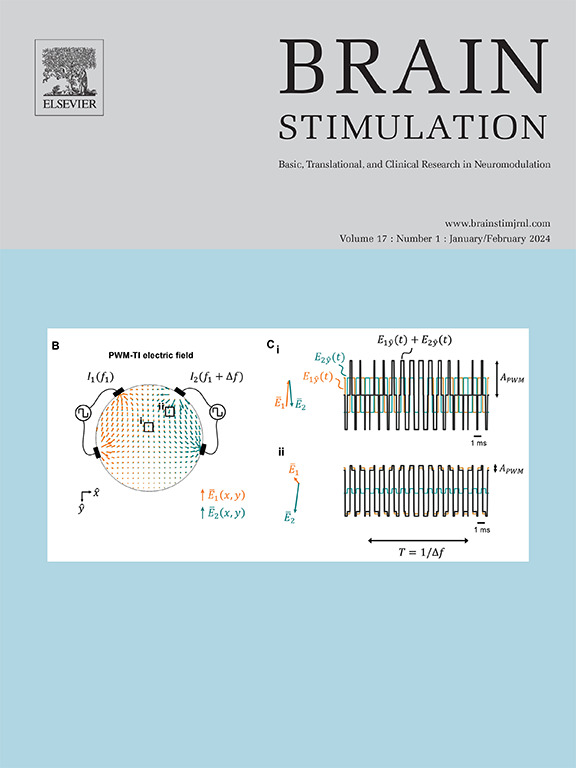Electrophysiological changes in the acute phase after deep brain stimulation surgery
IF 8.4
1区 医学
Q1 CLINICAL NEUROLOGY
引用次数: 0
Abstract
Background
With the introduction of sensing-enabled deep brain stimulation devices, characterization of long-term biomarker dynamics is of growing importance for treatment optimization. The microlesion effect is a well-known phenomenon of transient clinical improvement in the acute post-operative phase. While beta band activity is confirmed as a reliable biomarker for bradykinesia using chronic recordings, little is known about the ideal time point for initial electrophysiology-based programming.
Objective
To investigate the microlesion effect impact in chronic biomarker recordings.
Methods
Subthalamic peak biomarker power was continuously recorded during the first 40 post-operative days in 12 Parkinson's disease patients implanted with a sensing-enabled neurostimulator. Daily change in mean peak power and complexity was analyzed. Additionally, power spectral density at rest was compared between immediate postoperative period and three-months-follow-up. We additionally present continuous pallidal recordings in 2 dystonia patients.
Results
Mean peak power increased postoperatively, and the rate of change stabilized at 22–29 days. Peak power complexity showed a decrease in the number of recurrence states and laminarity, stabilizing around the same time point. Biomarker activity showed a significant increase at 3-month-follow up compared to the early post-operative phase. The microlesion effect was clinically reflected as a decrease in pre-vs. postoperative medication before setting of chronic stimulation parameters.
Conclusions
The transient postoperative microlesional effect is characterized by reduced beta band power and reduced neural signal complexity that gradually stabilize towards the end of the first month after surgery and most likely reflect local neuronal adaptation. These findings are important for the timing of electrophysiology-supported DBS programming, such as contact selection or adaptive algorithms.
脑深部电刺激术后急性期的电生理变化。
背景:随着传感脑深部刺激装置的引入,表征长期生物标志物动态对治疗优化变得越来越重要。微病变效应是术后急性期一过性临床改善的常见现象。虽然利用慢性记录证实β带活性是运动迟缓的可靠生物标志物,但对于初始基于电生理的编程的理想时间点知之甚少。目的:探讨微病变效应对慢性生物标志物记录的影响。方法:连续记录12例植入感觉神经刺激器的帕金森病患者术后前40天的丘脑下峰值生物标志物功率。分析了平均峰值功率和复杂度的日变化。此外,比较术后即刻和随访3个月的静息功率谱密度。另外,我们对2例肌张力障碍患者进行了连续的苍白球记录。结果:术后平均峰值功率增加,变化速率稳定在22 ~ 29 d。峰值功率复杂度呈现出递归状态数和层流数的减少,在同一时间点附近趋于稳定。与术后早期相比,生物标志物活性在3个月的随访中显着增加。微病变效应在临床上表现为在设定慢性刺激参数之前,术前与术后用药的减少。结论:术后短暂性微病灶效应以β带功率降低和神经信号复杂性降低为特征,并在术后1月末逐渐稳定,很可能反映了局部神经元的适应性。这些发现对于电生理学支持的DBS编程(如接触选择或自适应算法)的时序非常重要。
本文章由计算机程序翻译,如有差异,请以英文原文为准。
求助全文
约1分钟内获得全文
求助全文
来源期刊

Brain Stimulation
医学-临床神经学
CiteScore
13.10
自引率
9.10%
发文量
256
审稿时长
72 days
期刊介绍:
Brain Stimulation publishes on the entire field of brain stimulation, including noninvasive and invasive techniques and technologies that alter brain function through the use of electrical, magnetic, radiowave, or focally targeted pharmacologic stimulation.
Brain Stimulation aims to be the premier journal for publication of original research in the field of neuromodulation. The journal includes: a) Original articles; b) Short Communications; c) Invited and original reviews; d) Technology and methodological perspectives (reviews of new devices, description of new methods, etc.); and e) Letters to the Editor. Special issues of the journal will be considered based on scientific merit.
 求助内容:
求助内容: 应助结果提醒方式:
应助结果提醒方式:


